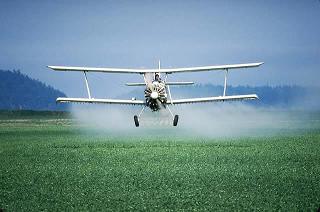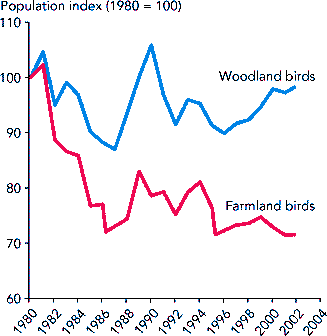 |
|
| PAN Europe | |
| > | About |
| > | PAN Europe Platform |
| > | PAN Europe members |
| > | PURE Campaign |
| > | Get Involved |
| News and Events | |
| > | Press Release |
| > | Conferences |
| > | News and articles |
| Resources | |
| > | About pesticides |
| > | About biocides |
| > | Paraquat Watch |
| > | Newsletter |
| > | Publications |
| > | Useful Links |
| > | Contact Us |
 |
|
|
|
|
 |
| PESTICIDE IMPACTS IN THE ENVIRONMENT
WATER CONTAMINATION Pesticide contamination of groundwater resources affects Belgium, Denmark, France, Germany, Netherlands and UK, where 5 to 10% of resources are found contaminated with levels of pesticide residues above 0.1µg/l. The majority of Europeans (65%) rely on groundwater for their drinking water. This situation also offers a major impact to local communities which depend on groundwater supplies. Using a ranking system, the substances which appear to most regularly cause problems across Europe as summarised below. The mark # indicates they are in the list of priority substances under the Water Framework Directive. Groundwater: The type of pesticide most commonly detected is herbicides, although other types have been identified in localised water resources. The substances are detected regularly, which indicates that best practice measures alone are unlikely to offer a solution. Pesticides have also been found in European rainwater. Approximately half of the compounds analysed were detected. For those detected, most concentrations were below 100 ng/l, but larger concentrations, up to a few thousand nanogrammes per litre, were detected at most monitoring sites. The most frequently detected compounds were lindane (gamma-HCH) and its related isomer (alpha-HCH), which were detected on 90-100% of sampling occasions at most of the sites where they were monitored. In total, 44 pesticide active ingredients have been found in European rainwater from 1990 onwards. They include: alachlor, atrazine, carbaryl, 2,4-D, diazinon, isoproturon, MCPA, mecoprop, and simazine (2). Calculation of external costs of water pollution exists for some countries. For many years the Dutch drinking water industry is confronted with the occurrence of pesticides in drinking water resources. To get an estimation of these costs for the drinking water industry VEWIN has asked Kiwa Water Research to set up an inquiry into these costs under all of the water companies in the Netherlands during the last ten years. The inquiry shows that the total costs amount about 240 million in the period of 1991 – 2000.
Source: (3) In Germany, Waibel and Fleischer started to work on a cost-benefit analysis of pesticides in Germany in 1992 and published a comprehensive book in 1998 (4). The book analyses benefits as well as external costs of pesticide use in the former Western Germany. The total costs amounted to 128.79 Million Euros, given the best scenario. This figure does not include chronic effects of pesticides on human health, long-term effects on the sustainability of agricultural production and soil fertility. Table 2 - Annual external costs of pesticide use in Germany
Source: (4) A UK study (5) estimates that UK uses 25 million kg of pesticides each year in farming – and some of these get into water. It costs water companies £120 million each year to remove pesticides – not completely, but to a level stipulated in law as acceptable (0.1 µg/litre for a single product and 0.5 µg/l for total pesticides). Water companies do not pay this cost –they pass it on to those who pay water bills. And so this also represents a hidden subsidy to those who pollute. Equally, those who do not pollute do not receive this hidden subsidy. Pesticides are known to have adverse impacts on a wide range of non-target organisms including birds, fish, and beneficial insects. For example, in-field biodiversity has been reduced by the use of herbicides for weed control, which some researchers claim has contributed to recent falls in the numbers of some bird species. A 1997 report (6) cited pesticide use as a major factor in the decline of many bird species over the last 30 years or so. The main examples were: tree sparrows (-89%), turtle doves (-77%), bullfinches (-76%), song-thrushes (-73%), lapwings (-62%), reed buntings (-61%), skylarks (-58%), linnets (-52%), swallows (-43%), blackbirds (-42%), starlings (-23%). Figure - Evolution of woodland and farmland birds in Europe
Source: Birdlife Several investigations in Germany verify that areas close to organic farms are characterised by a greater biodiversity than areas close to conventional farms. The variability of organisms can be up to 6 times higher in land in organic farming as compared to land in conventional agriculture (7). One investigation found that species listed on the IUCN Red List of Threatened Species could be found in 79% of the agricultural areas sampled where organic farming had been applied for at least 25 years, whereas Red List species could be found on only 29% of land in conventional agriculture (8), beetles were 94% more abundant in organic fields than in the conventional ones. The number of beetle species was 16% higher. The same report found that inappropriate use of pesticides, and in particular nematocides, can have very negative effects on soil biodiversity because of their poor selectivity. Some studies suggest that some herbicides considerably suppress soil bacteria and fungi activity. Of the more than 130 different plants found naturally around Germany’s agricultural land, half are currently considered endangered, and some have already disappeared (9). Another German study calculated the cost of the loss of biodiversity in Germany through the use of pesticides at 10 million DM (~5 million Euros) per year (10). Danish studies also stress the negative effects of pesticides on biodiversity. According to the Bichel Report, the effects of pesticide use on above-ground arthropods are significant, and a larger insect population could be expected in the event of a phase-out of pesticide use (11). According to a Danish 2002 report (12), half and quarter dosages of herbicides and insecticides improve the "natural elements" of the fields with an increased number of weed species, increased proportion of flowering species and increased abundance of insects. Use of half the dose only creates negligible, if any, agricultural problems, especially if supplementary control of particular weed patches is carried out. Sources (1) EUREAU (2001), Keeping raw drinking water resources safe from pesticides, Position paper EU1-01-56, April 2001. Available online at: http://www.eeb.org/activities/water/EU1-01-A56-pesticides-final.pdf (2) IG Dubus, JM Hollis and CD Brown (2000), Pesticides in rainfall in Europe, Environmental Pollution, Vol,110, 331-344. (3) KIWA (2001), Door drinkwaterbedrijven gemaakte kosten als gevolg van bestrijdingsmiddelengebruik, Inventarisatie over de periode 1991-2000, Kiwa N.V. Water Research, Nieuwegein. (4) Waibel, H. and G. Fleischer (1998): Kosten und Nutzen des chemischen Pflanzenschutzes in der deutschen Landwirtschaft aus gesamtwirtschaftlicher Sicht (Social costs and benefits of chemical plant protection in German agriculture), Kiel, Vauk Verlag, Germany. (5) J.N. Pretty, C. Brett, D. Gee, R.E. Hine, C.F. Mason, J.I.L. Morison, H. Raven, M.D. Rayment, G. van der Bijl (2000), An assessment of the total external costs of UK agriculture, Agricultural Systems 65 (2), pp. 113-136. (6) Campbell, L.H. and A.S. Cooke (1997), The indirect effects of pesticides on birds, Joint Nature Conservation Committee, Peterborough, UK. (7) Frieben, B. & U. Köpke. Effects of farming systems on biodiversity, in: Isart, J. & J. J. Llerena (eds.): Biodiversity and Land Use: The Role of Organic Farming (1997). Proceedings of the first ENOF-Workshop, Bonn, 11-21; Van Elsen, Th: 1994: Die Fluktuation von Ackerwildkraut-Gesellschaften und ihre Beeinflussung durch Fruchtfolge und Bodenbearbeitungszeitpunkt. Diss. agr. Universität Gesamthochschule Kassel, 415 S. (8) Frieben, B. (1990), Bedeutung des Organischen Landbaus für den Erhalt von Ackerwildkräutern (Relevance of the organic farming for the preservation of wild herbs organisms), Natur und Landschaft (65), Heft 7/8, 379-382). In a two-year study in Austrian soils |( Cited in Commission Communication Towards a Thematic Strategy for Soil Protection 16-04-02, COM/2002/179 final. (9) MURL-Ministerium für Umwelt, Raumordnung und Landwirtschaft des Landes Nordrhein-Westfalen (1988), Schutzprogramm für Ackerwildkräuter (protection programme for wild herbs on agricultural fields), Fassung. Umweltschutz und Landwirtschaft. Schriftenreihe des Ministeriums für Umwelt, Raumordnung und Landwirtschaft Nordrhein-Westfalen, Heft 3. (10) Waibel, H. Experience with Cost Benefit Studies of Pesticides in Germany. (11) The Bichel Committee (1999), Report from the main committee to assess the overall consequences of phasing out the use of pesticides. (12) Esjberg, Peter and Petersen Bo Svenning (2002), Effects of reduced pesticide use on flora and fauna in the agricultural fields, Pesticides research 58, Danish Environmental Protection Agency.
LINKS Birdlife International: http://www.birdlife.org/news/news/2004/01/farm_birds.html Danish Environmental Protection Agency: http://www.mst.dk/homepage/ EUREAU - European Union of National Associations of Water Suppliers and Waste Water Services: http://www.eureau.org/ |
||||||||||||||||||||||||||||||||||||||||||||||||||||||||||||||||||||||||||||||
Site last updated:
4 August, 2006 |
| PAN Europe, Development House, 56-64 Leonard Street,
London EC2A 4JX Tel +44-20 7065 0920, Fax +44-20 7065 0907, email sofia-paneurope@pan-uk.org, www.pan-europe.info |
